Greece is a small country where European civilization started about 2,500 years ago. In those days, Greece controlled much of the land bordering the Mediterranean and Black seas. Athens is the capital and the largest city of Greece. In Athens and many other parts of Greece, magnificent ruins stand as monuments to the nation’s glorious past.
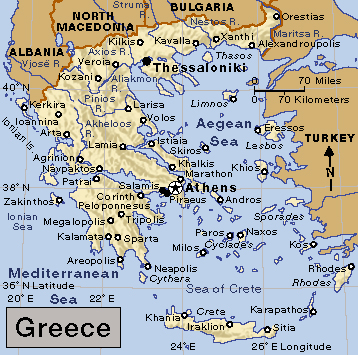
About one-tenth of the workers in Greece earn their living by farming. Agriculture is an important economic activity. But mountains cover most of Greece. The land is rocky with little fertile soil. A Greek legend tells that God sifted the earth through a strainer while making the world. He made one country after another with the good soil that sifted through. God threw away the stones left in the strainer. According to the legend, these stones became Greece.
No part of Greece is more than 85 miles (137 kilometers) from the sea. The Greeks have always been seafaring people. About a fifth of Greece consists of islands. The mainland makes up the southern tip of the Balkan Peninsula. The country extends into the Mediterranean Sea. Many ancient Greek legends, including those about Odysseus and Jason, center on sea voyages. Today, Greece has one of the largest merchant fleets in the world.
The ancient city-states of Greece were conquered by the kingdom of Macedonia in 338 B.C. In the 140’s B.C., the Roman Empire took control of Macedonia and Greece. Greece remained part of larger empires until 1829. That year, it won its independence from the Ottoman Empire. Until the 1970’s, Greece had many serious political problems, largely because of weak or undemocratic governments.
In ancient times, the Greeks established the traditions of justice and individual freedom that are basic to democracy. Their arts, philosophy, and science became foundations of European thought and culture. See the World Book article on Greece, Ancient.
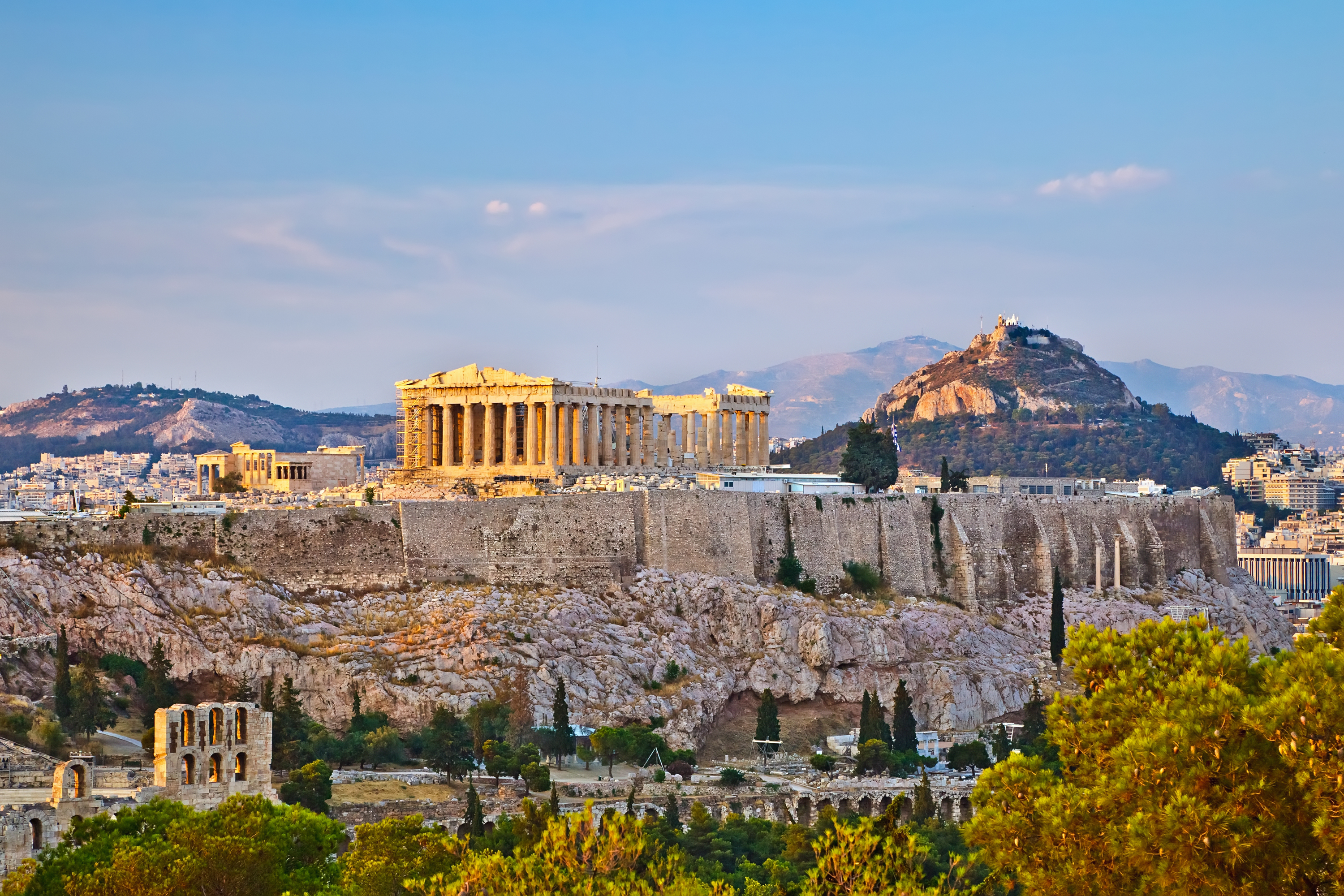
Government
National government.
Greece adopted its present constitution in 1975. This document officially eliminated the monarchy that had ruled Greece. It made the nation a parliamentary republic headed by a president. The president now serves as head of state but mainly performs ceremonial duties. The prime minister, who serves as head of government, holds the real power. The president is elected by the parliament to a five-year term. The president appoints the prime minister. The prime minister must then win a vote of confidence from the parliament. The prime minister is usually the leader of the party with the most seats in the parliament.
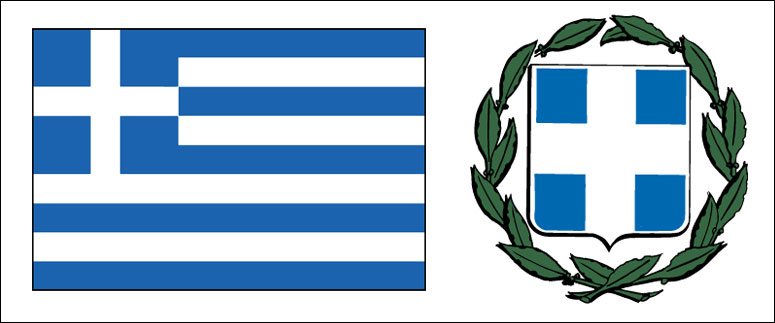
Greece national anthem
Executive power is exercised by the Cabinet. The Cabinet consists of the prime minister and various departmental ministers. The Cabinet forms and directs general governmental policy. The president appoints the departmental ministers on the advice of the prime minister.
The parliament, Greece’s lawmaking body, is called the Vouli. It consists of a single house. The members, called deputies, are elected to four-year terms.
Local government.
Greece is divided into 13 regions. The regions are further divided into 74 regional units. Mount Athos, a self-governing community of monks, is an independent district that is not part of a region. Local municipalities and communities are governed by an elected chief executive—either a mayor or a president—and an elected council.
Politics.
Greece’s main political parties include the Panhellenic Socialist Movement (PASOK), the New Democracy Party, and the Radical Coalition of the Left (SYRIZA). PASOK supports social welfare programs and government intervention in the economy to protect workers. The conservative New Democracy Party favors a free market economy with limited government interference in private business. SYRIZA, a leftist party formed in 2004, operates as an opposition group to both PASOK and the New Democracy Party. The three parties differ in their approaches to the economy and to Greece’s role within the European Union, as well as to other issues. Smaller political parties include the Communist Party of Greece and the right-wing extremist group Golden Dawn. Greeks who are at least 17 years old are required to vote.
Courts.
The Special Supreme Tribunal is the highest court in Greece. The court rules on the constitutionality of laws in some cases. It also decides election and referendum disputes. The regular court system consists of administrative, civil, and criminal courts; appellate courts; and a Supreme Court. Judges are appointed for life by the president.
Armed forces.
Greece has an army, navy, and air force. Because of tensions with its neighbors—particularly Turkey—Greece devotes a substantial portion of its national budget to defense. Greek men are required to serve up to 12 months on active duty in the armed forces. They become eligible for the draft at age 18. Greek women may volunteer for military service.
People
Population.
Greece’s capital, Athens, is also its largest city. About 30 percent of all Greeks live in Athens or its suburbs. Thessaloniki is the second largest city. The most densely populated areas of Greece are the coastal and interior plains. The mountainous areas are lightly populated. So are many of the Aegean Islands. Ethnic Greeks make up about 95 percent of Greece’s population.
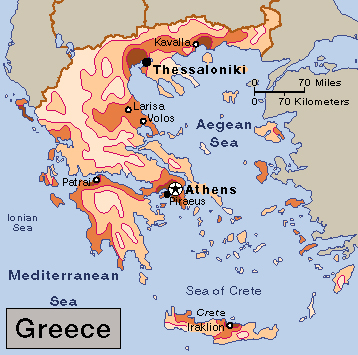
Ancestry.
Various groups of people invaded Greece and settled there. As a result, some segments of the population have been influenced by such ethnic groups as the Italians, Slavs, and Turks.
Language.
Greek is the official language of Greece. The people use a modern form of Greek called demotic. It includes words and phrases borrowed from many languages, especially English, French, Italian, Slavic, and Turkish. See Greek language.
Way of life
City life.
The majority of Greece’s people reside in urban areas. Most Greek cities consist of both old and modern sections. The old section of a Greek city has low buildings, narrow streets, and few sidewalks. The modern section usually has tall apartment buildings, wide streets, and modern shopping areas. Urban lifestyles in Greece are similar to those in other Western nations. Greek cities boast modern mass transit systems. They also have an abundance of shopping centers and drive-in restaurants. Most city dwellers work in tourism, commerce, or shipping. 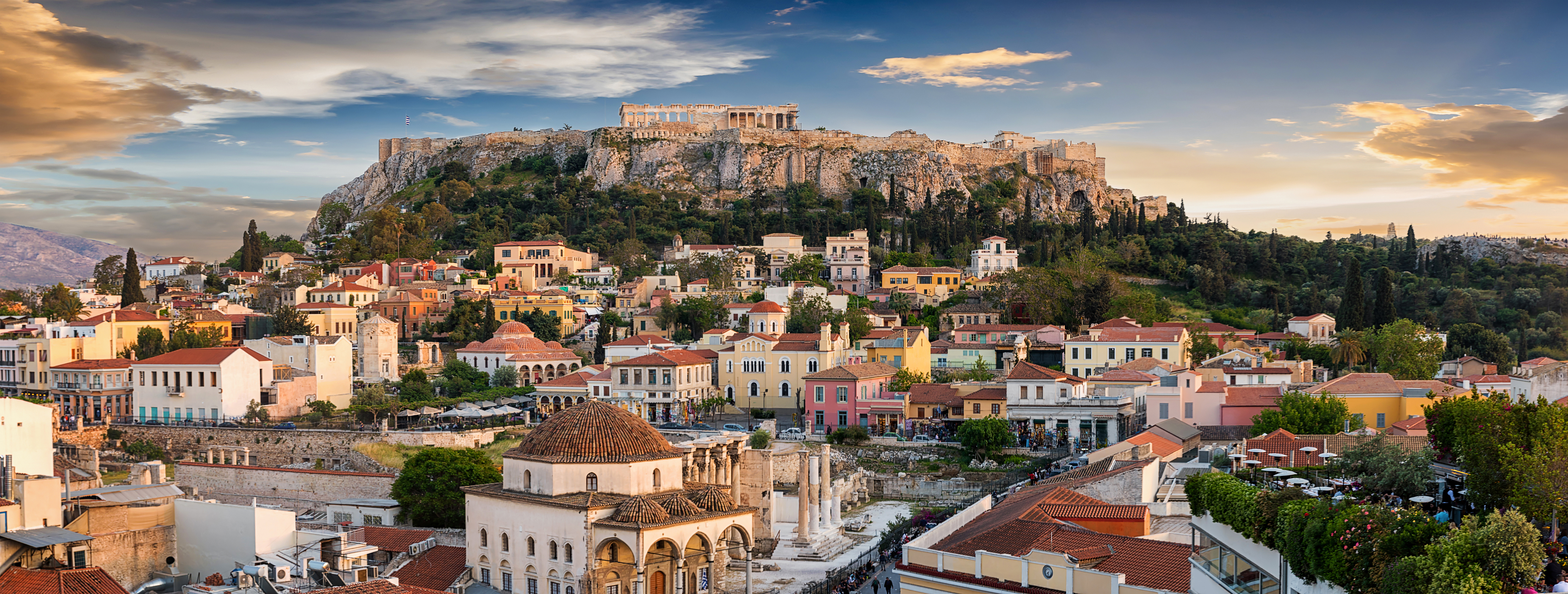
Greek cities are mostly free of slums. But the cities face some challenges. Population growth has led to housing shortages in many Greek cities. Industrial growth and the increased use of automobiles have led to problems of urban pollution. In Athens, air pollution poses a health hazard. Polluted air has damaged the city’s ancient ruins. Athens has tried to ease this problem by tightening controls on industry. The city has also banned automobiles from certain sections and limited the number of automobiles moving through the city each day.
Rural life.
Since the 1960’s, the population has declined in rural areas—especially in the mountains. Many rural people have left farms to seek jobs in the cities. As a result, many small farms in the mountains have been abandoned. Today, the largest Greek farms lie in the coastal and interior plains. Irrigation there produces high crop yields. These profitable farms have led to an improved quality of rural life. Houses are centrally heated and have indoor plumbing and electric power. Modern, paved roads link rural settlements to cities and towns.
Rural Greeks are strongly attached to their communities. Many Greeks who have migrated to the cities own land and a summer house in their rural village.
Clothing.
Today, Greeks wear clothing like that worn elsewhere in Europe. Traditional dress includes braided jackets and pleated kilts for men. Such costumes are worn only during public social events or celebrations. Traditional dress varies from region to region.
Food and drink.
The Greek diet includes a variety of meats, such as lamb, chicken, pork, and beef. Greeks also eat many fresh vegetables, such as tomatoes, eggplant, and beans. Meats and vegetables are often combined in stews. Greeks enjoy many different cheeses, some of which are regional specialties.
The Greeks eat more lamb than any other meat. They also serve a wide variety of fish and other seafood from the Mediterranean Sea. They almost always cook food in olive oil and often use olive oil for flavoring. Greek cooking also uses oregano, garlic, onions, and fennel (an herb related to parsley) as seasonings.
Popular meat dishes include dolmathes (grape leaves filled with rice and ground meat), moussaka (layers of eggplant and ground meat), and souvlaki (meat cooked on a spit). A popular soup is soupa avgolemono (lemon-flavored chicken soup). Also popular are olives and feta (a cheese made from sheep’s or goat’s milk). Fresh fruit is a common dessert. Greeks also enjoy a wide variety of sweet pastries.
Popular beverages include beer and retsina (a white wine flavored with pine resin). Greeks like to drink ouzo (a strong, anise-flavored liquor) and brandy. Favorite hot beverages include tea and a dark, thick coffee.
Recreation.
Greeks enjoy sports, particularly soccer, basketball, and swimming. They also enjoy socializing in outdoor theaters, cafes, and restaurants. On weekends and holidays, Greeks like to travel to visit with friends and relatives in other parts of the country. 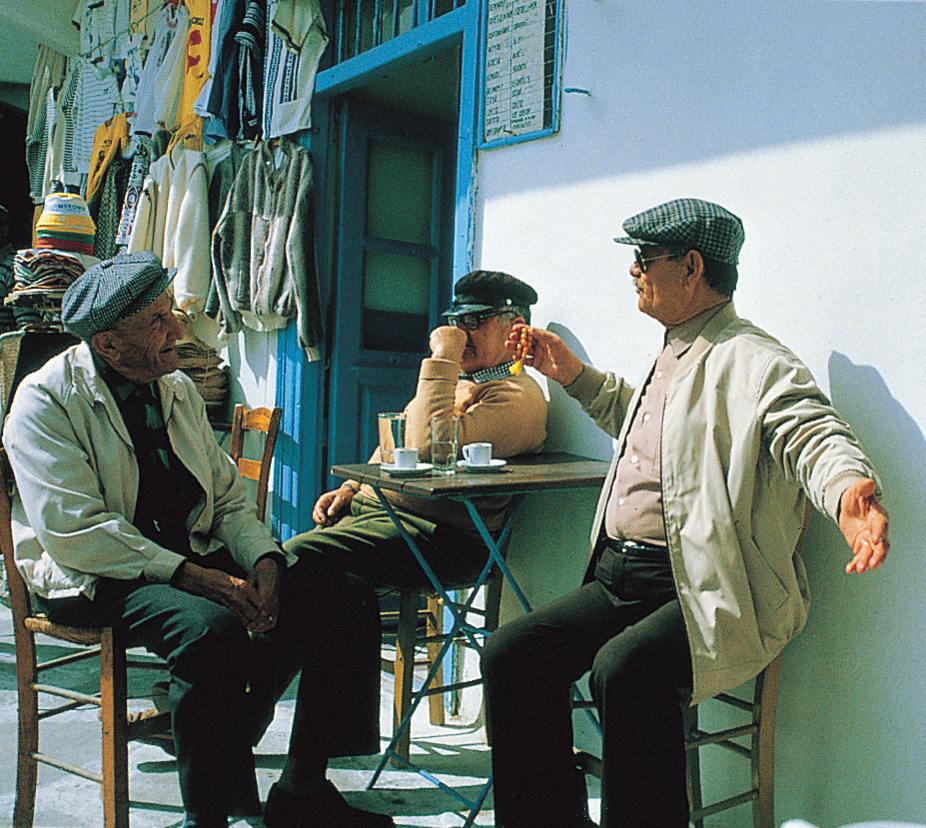
Religion.
About 98 percent of Greece’s people belong to the Greek Orthodox Church. Greek Orthodoxy is the nation’s official religion, but everyone has freedom of worship. The Greek Orthodox Church is a self-governing member of the Eastern Orthodox Churches. It is headed by the archbishop of Athens. The archbishop is called the primate of Greece (see Eastern Orthodox Churches). Another archbishop, the ecumenical patriarch of Constantinople, has spiritual jurisdiction over some parts of Greece. They include Crete, the Dodecanese Islands, and the communities of monks on Mount Athos. The Greek government pays the salaries of Greek Orthodox clergy. Other religious groups in Greece include Roman Catholics, Jews, Protestants, and Muslims. Muslims live mainly in Thrace.
Most Greeks attend church during such events as baptisms, weddings, and funerals, and during the major religious holidays of Easter and Christmas. Easter is the most important religious holiday in Greece. The people serve lamb feasts on Easter Sunday. Instead of giving presents on Christmas, many Greeks do so on St. Basil’s Day, which falls on New Year’s Day. See Basil, Saint. 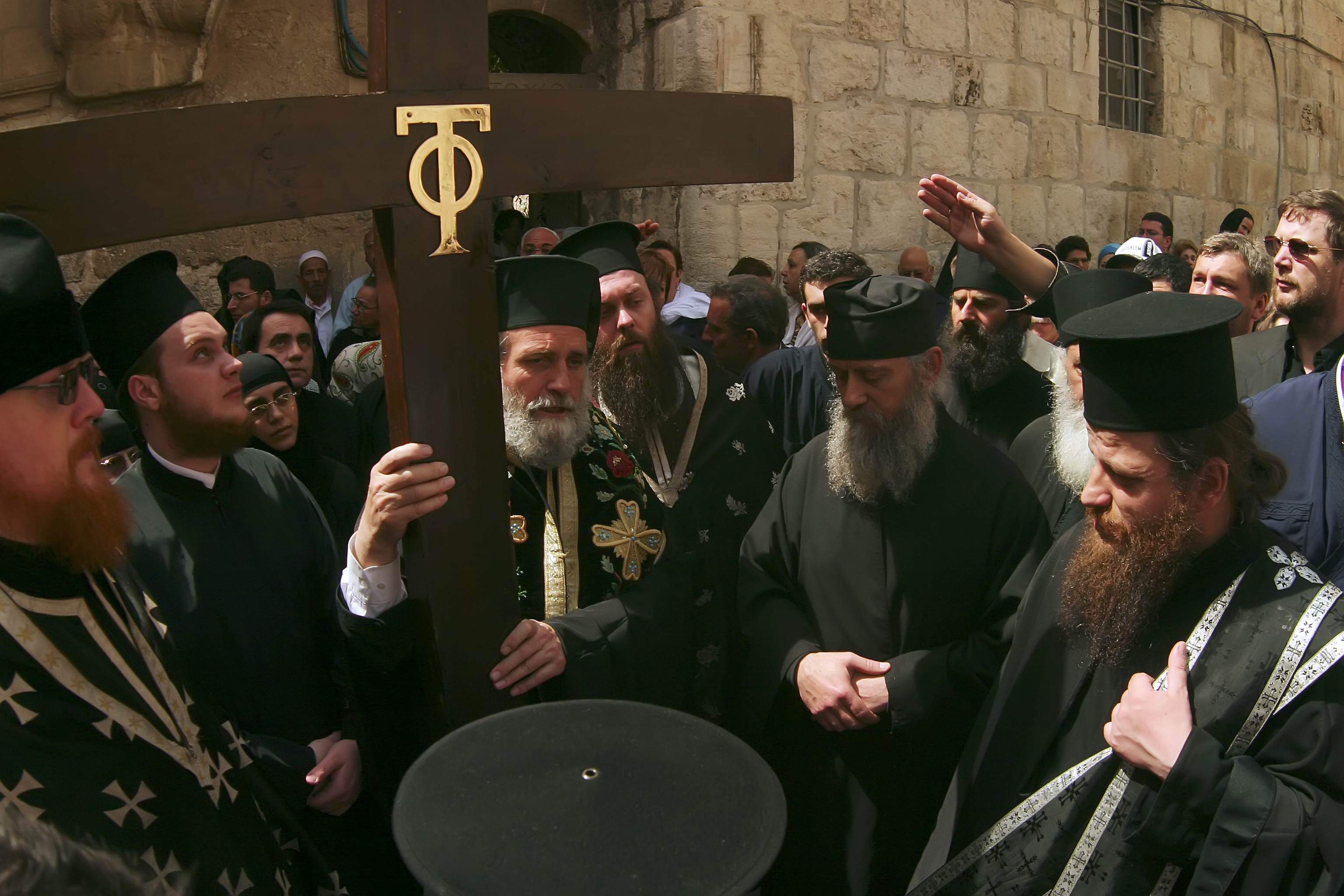
Greek Orthodox festivals help maintain religious influence throughout the country. Every major settlement has a patron saint. The people may go to church on the evening before the saint’s yearly feast day, as well as on the feast day. After the evening service, they enjoy food and wine. They sing and dance far into the night.
Education.
Greek law requires children to go to school from the age of 6 through 15. Elementary school lasts through the sixth grade. A six-year high school program follows. All public education in Greece is free.
Greece has a strong educational tradition. Nearly all of the country’s adult population can read and write. Enrollment in higher education programs increased greatly in the last half of the 1900’s.
Greece has numerous universities and colleges. The largest are the Aristotle University of Thessaloniki and the National and Kapodistrian University of Athens. There are also a number of schools for archaeology and for the fine arts. In addition, Greece has numerous technical and professional schools.
Arts.
The most famous artist born in Greece was probably Domenikos Theotokopoulos. He became known as El Greco (the Greek) in Spain. He did most of his painting there during the late 1500’s and early 1600’s. Important Greek writers of the 1800’s and 1900’s included the poets George Drosines, Kostis Palamas, and Dionysios Solomos. Others were Nikos Kazantzakis, a novelist, and Alexander Papadiamantis, known for his short stories. Two Greek poets have won the Nobel Prize in literature. George Seferis won the prize in 1963. Odysseus Elytis received the award in 1979. Important Greek composers of the 1900’s included Manos Hadjidakis, Nikos Skalkottas, and Mikis Theodorakis. Greece was also the home of the conductor Dimitri Mitropoulos and the opera singer Maria Callas.
Loading the player...Greek popular music
Many Greeks are skilled weavers of colorful rugs or articles of clothing. Embroidery is another important handicraft in Greece. Greek silversmiths hammer silver into heavy necklaces and other beautiful jewelry. Traditional Greek folk dances are held at local festivals and other celebrations. The people dance to folk music that features clarinets and bouzouki (a stringed instrument that resembles a mandolin). Festivals of ancient Greek dramas are held regularly in bowllike outdoor theaters that were built before the time of Christ.
The land
Much of the land of Greece is composed of limestone. The rock is either bare or covered with thorny, woody shrub vegetation called maquis. Soils in the uplands, which cover about 70 percent of the country, are poor and stony. However, several large coastal and interior areas have rich soils.
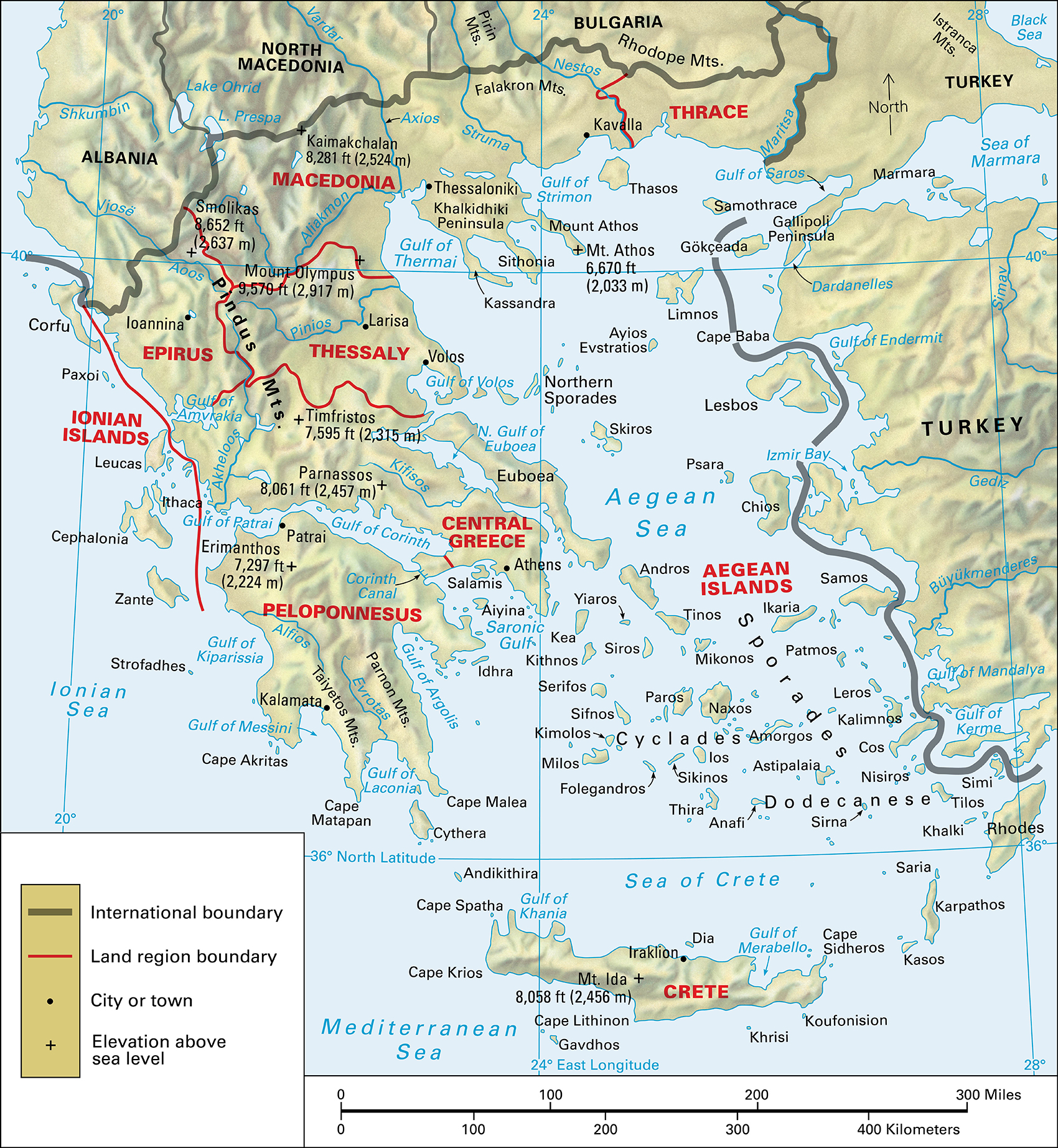
Mountains divide Greece into many land regions. High peaks cut off valleys and plains from one another. The Pindus Mountains, for example, form a barrier between the east and west sections of the mainland. These heavily forested mountains rise over 8,000 feet (2,400 meters) above sea level. Water also shapes the land regions of Greece. Long arms of the sea reach into the coasts, forming many peninsulas. Greece’s hundreds of islands together make up about 20 percent of the country.
Greece has nine main geographic regions. They are Thrace, Macedonia, Thessaly, Epirus, Central Greece and Euboea, the Peloponnesus, the Ionian Islands, the Aegean Islands, and Crete.
Thrace
lies in the extreme northeastern section of Greece, west of Turkey and south of Bulgaria. The region is dominated by the massive, barren Rhodope Mountains near the Bulgarian border. A narrow plain stretches along the coast. An Oriental variety of tobacco is grown in the region. Thrace is the home of Greece’s largest group of Turkish-speaking Muslims.
Macedonia
extends westward from the region of Thrace. It includes portions of the Pindus and southern Balkan mountains. It also has several fertile valleys. Macedonia ranks as the most productive agricultural region of Greece. It boasts two rich agricultural plains—Thessaloniki and Serrai. Major crops include corn, cotton, fruits, rice, tobacco, and wheat. Thessaloniki, the region’s largest city, is second only to Athens in size and industrial production. It is also a major port. Ptolemais, in the Pindus Mountains of western Macedonia, is the site of the country’s principal lignite mines. Lignite is a type of coal. The self-governing religious community of Mount Athos lies on the easternmost prong of the Khalkidhiki Peninsula in eastern Macedonia. There, about 2,000 monks live in 20 monasteries. 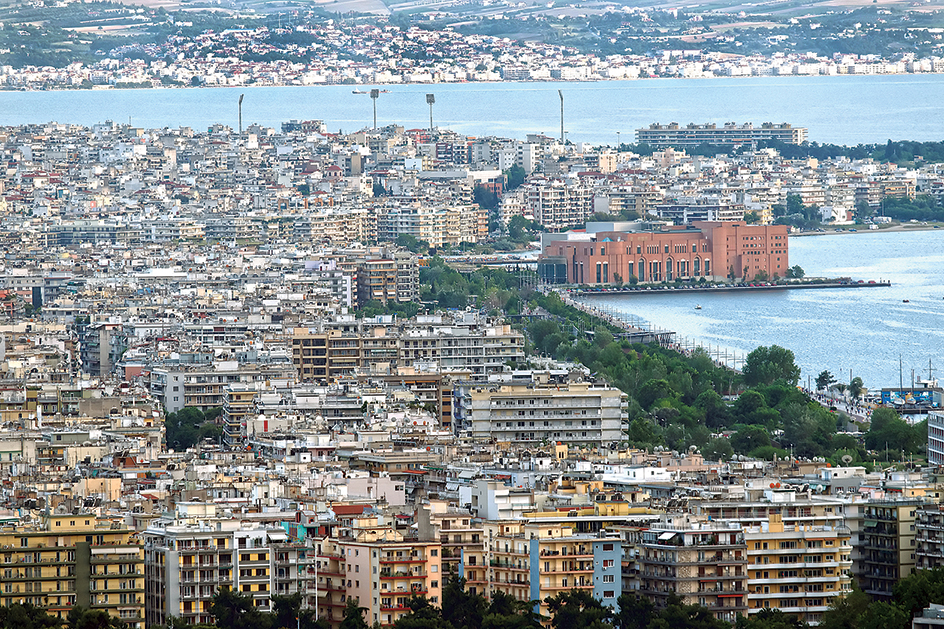
Thessaly
lies south of Macedonia. The region is a large plain nearly surrounded by tall mountains. The mountains include 9,570-foot (2,917-meter) Mount Olympus, the highest peak in Greece. Thessaly has long been an important grain-growing area. Wheat is still a major crop. Thessaly also grows more cotton than any other region. Other crops include olives and vegetables. The port city of Volos is the commercial center of the region.
Epirus
is a small, sparsely populated region. It lies in the northwestern part of the country between Albania and the Gulf of Amvrakia. Its mountainous terrain makes travel difficult. Ioannina, which lies in a major valley, is the largest city in Epirus. Crops grown in the region include citrus fruits, grapes, and rice. Sheep graze in the mountains. Wool is an important product.
Central Greece and Euboea
lie south of Epirus and Thessaly. Central Greece is a region of mountains and hills, small valleys, and many islands. It makes up only about one-fifth of Greece but has nearly half the total population. The Greater Athens area is the nation’s leading financial and industrial center. The Athens area is also a communications and transportation hub. It includes the port city of Piraeus and many coastal industrial cities and tourist attractions. In addition to the famous ancient ruins in Athens itself, there are those of Eleusis and other nearby historic sites. The region produces cotton, figs, grains, and olives. Marble and lead are important mineral products. Bauxite is mined at Mount Parnassos. A large aluminum factory operates on the Gulf of Corinth.
The Peloponnesus
is a large peninsula with small valleys and rugged mountains and coastlines. The Corinth Canal cuts through the isthmus that connects the region with the rest of the mainland. The canal makes the Peloponnesus almost an island. Maquis and scattered pine forest make up the principal plant life. Crops grow on less than 20 percent of the land area, mainly in the coastal plains. The hief crops are citrus fruits, grapes, olives, and vegetables. The Peloponnesus is one of the most historically famous parts of Greece. Ancient temples and ruins stand at Corinth, Epidaurus, Mycenae, Navplion, Olympia, and other historic sites.
The Ionian Islands
lie in the Ionian Sea, west of the Greek mainland. The largest and most heavily populated ones are Cephalonia, Corfu, Leucas, and Zante. One tourist attraction is the island of Ithaca, home of Odysseus in the epic poem The Odyssey. Crops grown in the Ionian Islands include citrus fruits, grapes, olives, and vegetables. Sheep and goats graze on the mountains.
The Aegean Islands
lie in the Aegean Sea between the Greek mainland and Turkey. These islands are rocky. Few people live there. The northern islands include Chios, Lesbos, Limnos, Samothrace, Thasos, and the Northern Sporades group. To the south are the Cyclades group and the Dodecanese Islands. Major tourist attractions in the Aegean Islands are Rhodes, Delos, Tinos, Paros, Mikonos, and Siros. Another attraction is the island of Thira. Some historians believe Thira is the lost continent of Atlantis.
Crete,
in the Mediterranean Sea, is the largest Greek island. It consists mainly of hills and mountains with some fertile valleys. A narrow plain extends along the northern coast. The northern plain has the largest cities and some light manufacturing. Along the southern coast, mountains slope steeply to the sea. The major tourist attraction is the famous ruins of Knossos. Knossos was the center of the ancient Minoan civilization.
Climate
Greece has a so-called Mediterranean climate. It has mild, wet winters and hot, dry summers. However, the climate varies sharply between the mountainous interior and coastal regions. Temperatures average about 40 °F (4 °C) in winter. Temperatures average above 75 °F (24 °C) in summer in coastal locations.
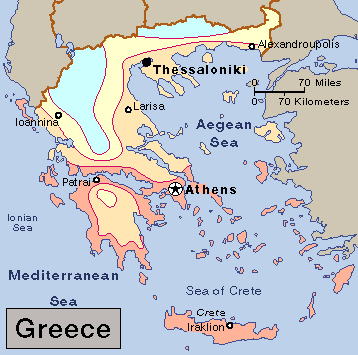
In much of Greece, about three-fourths of the total rainfall occurs in winter. Snow is rare in the lowlands but falls in the high mountains. During the summer, skies are nearly cloudless. Cool sea breezes blow along the coasts every day.

Westerly winds are responsible for most of Greece’s rain and snow. These warm, moist winds cool as they rise along the west-facing mountain slopes. As they cool, they drop moisture in the form of rain and snow. Because of this pattern, most of the western mountain slopes are wetter and greener than the eastern slopes.
The precipitation in Greece decreases from the northwest to the southeast. It averages more than 60 inches (150 centimeters) a year in northern areas of the Pindus Mountains. The driest areas, such as on the island of Kea in the Cyclades, get less than 15 inches (38 centimeters). The rain usually falls in heavy but brief showers.
Nearly all of Greece’s rivers dry up in summer because of the lack of rain. As a result, fresh water must be stored during the winter for use in summer.
Economy
The economy of Greece was almost destroyed during World War II (1939-1945) and during the Greek civil war (1946-1949). Although still weak by European standards, the Greek economy expanded greatly from the 1950’s until a government deficit threatened it in the first decade of the 2000’s. The economic expansion resulted from several causes. The most important causes included government programs and economic aid from the United States. Greece also prospered because of trade with the Middle East and with members of the European Union. The European Union is an organization of European nations that cooperate with one another in economic and other matters (see European Union (EU)).
Greece’s economy has struggled since the first decade of the 2000’s. In the early 2010’s, the European Union and International Monetary Fund loaned Greece hundreds of billions of dollars. Greece has a high unemployment rate, and many people live in poverty.
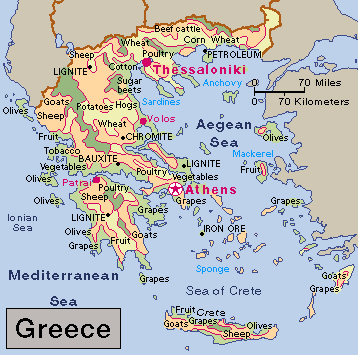
Service industries,
taken together, account for about 80 percent of Greece’s gross domestic product (GDP). GDP is the total value of goods and services produced within a country in a year. Service industries employ about 75 percent of the country’s workers. Greece’s leading service industry category is community, government, business, and personal services. Tourism benefits many of Greece’s service industries.
Manufacturing
accounts for about 10 percent of both the nation’s GDP and its employment. Leading industrial products include aluminum, cement, chemicals, cigarettes, clothing, electrical equipment, pharmaceuticals (medicinal drugs), processed foods and beverages, and textiles. Industrial activity is concentrated in Athens and Thessaloniki.
Agriculture
contributes about 5 percent to Greece’s GDP. It employs roughly 10 percent of the work force. Greece has dry summers and little fertile soil. About 80 percent of the land is mountainous. Most Greek farms are small. Crops grow on about 30 percent of the total land area. About 35 percent of the land consists of pastures or meadows.
Olives are Greece’s leading crop. Greece is among the leading olive-growing countries. Corn and wheat are Greece’s main field crops. Other major crops include cotton, grapes, oranges, peaches, and tomatoes.
Greek farmers raises cattle, goats, and sheep for both meat and milk. Farmers also raise chickens and hogs. Greece imports much of its livestock, meat, and dairy products from other countries.
Fishing industry.
Greece’s most important commercial fish include anchovies, hake, mackerel, and sardines. Much of the fish catch comes from the northern part of the Aegean Sea. Aquaculture, the commercial raising of animals and plants that live in water, is a growing industry in Greece. Sea bass and sea bream are the most valuable products.
Tourism
benefits many of Greece’s industries. Many tourist hotels and other facilities have been built since the 1950’s. Tourism has increased rapidly. Today, millions of tourists visit Greece each year. Most of these visitors come from other European countries. The main countries sending visitors include Albania, Bulgaria, France, Germany, Italy, the Netherlands, and the United Kingdom.
Athens, one of the world’s most historic cities, attracts many of the tourists who come to Greece. The Acropolis, the center of ancient Athens, is the most famous attraction. The Acropolis is a rocky hilltop that has the beautiful ruins of the Parthenon and several other ancient temples. See Acropolis; Parthenon. 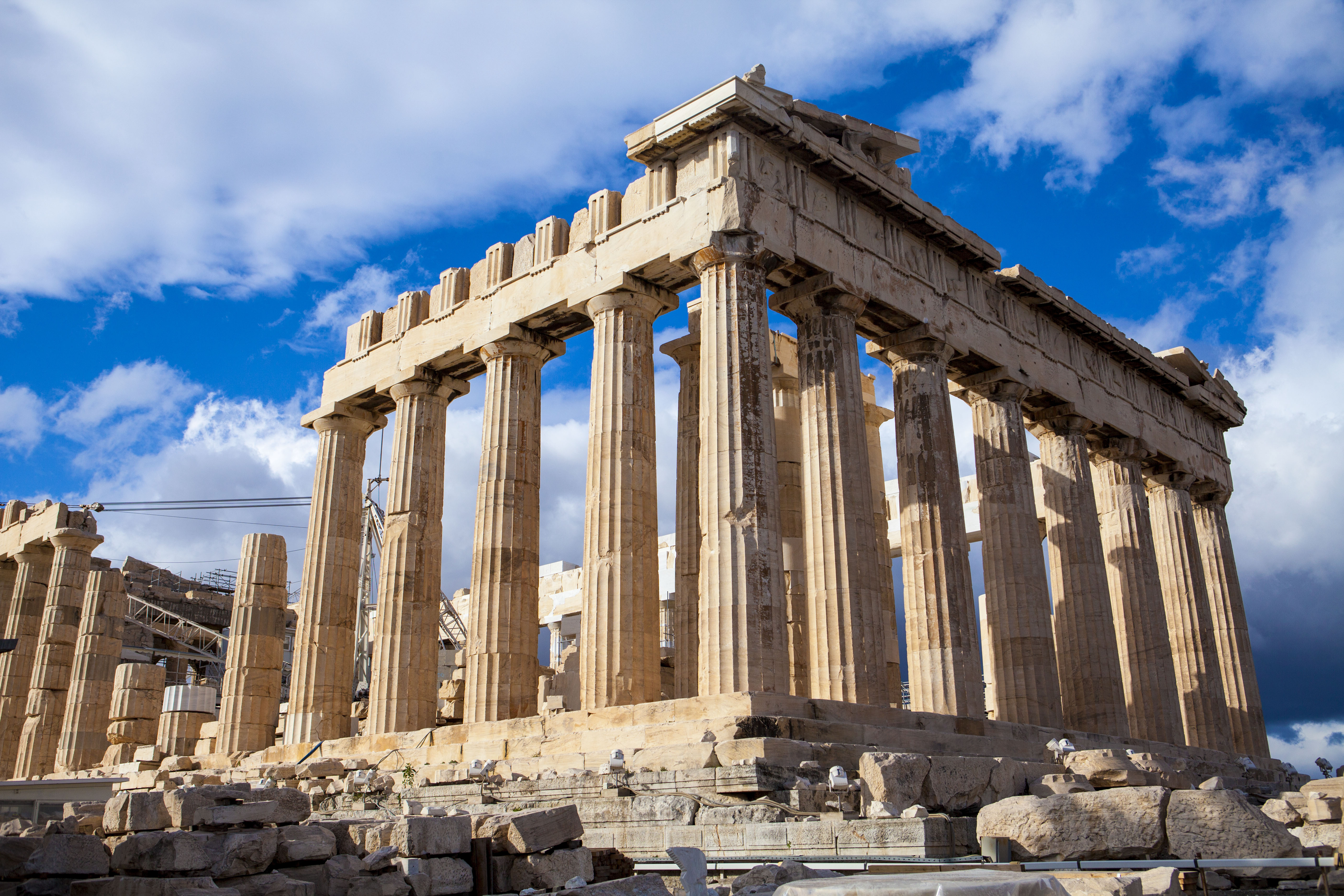
The Peloponnesus has the most varied ruins of ancient Greece. It includes such historic areas as Corinth, Epidaurus, Mistra, Mycenae, Olympia, and Sparta. In northern Greece are Thessaloniki and Ioannina, centers of the old Byzantine Empire. Another popular tourist area is the religious community of Mount Athos, though women are not allowed there. The islands of Corfu, Crete, Mikonos, Rhodes, Thasos, and Thira draw many visitors.
Mining.
Greece has varied but limited mineral deposits. Low-quality brown coal called lignite is a major mineral product. Most of it is used to generate electric power. The largest lignite deposits are in the Ptolemais basin of the Pindus Mountains, the island of Euboea, and the central Peloponnesus. Another important mineral is bauxite, the ore from which aluminum is made. Greece also produces bentonite, iron ore, lead, magnesite, nickel, perlite, pumice, silver, and zinc. Greece has large deposits of marble and clays. The country has only one important petroleum deposit, near the island of Thasos in the Aegean Sea.
International trade.
Greece’s most important exports include aluminum, copper, fruits and vegetables, machinery, olive oil, petroleum products, and pharmaceuticals. Greece imports crude oil, food products, machinery, motor vehicles, pharmaceuticals, and ships.
The value of imported products is about two times that of the country’s exports. The difference is made up by income from shipping and tourism, and by money sent home by Greeks who live or work elsewhere. Greece’s leading trading partners include Belgium, Bulgaria, China, France, Germany, Iraq, Italy, the Netherlands, Russia, South Korea, Spain, the United Kingdom, and the United States.
Energy sources.
In 1961, about 45 percent of the dwellings in Greece had no electric service. Since then, power production has increased enormously. By 1990, only a few remote areas were still without electric service. Plants that burn lignite or petroleum produce most of Greece’s electric power. Greece also has several hydroelectric plants. Most of them are on the Akheloos River and other rivers in the Pindus Mountains.
Greece has only limited deposits of petroleum and natural gas. Consequently, it imports most of its crude petroleum and natural gas. But Greece is exploring methods of electric power production involving solar, geothermal, and wind power to reduce its dependence on imported petroleum.
Transportation.
The mountains of Greece make transportation difficult. Most overland routes go through valleys and natural breaks in the mountains. The principal highway and rail routes connect Athens and Thessaloniki, the country’s two largest cities. The railroad system links Greece’s major cities and provides international connections.
The Greek merchant fleet ranks among the largest in the world. Piraeus, near Athens, is Greece’s leading port. Iraklion, Patras, and Thessaloniki also have important ports. A fleet of small ships provides transportation among the islands. None of the rivers can be traveled because they flow too swiftly during the wet season and dry up in summer.
Greece’s major international airports are in Athens, Iraklion, and Thessaloniki. Olympic Air, the national airline, flies within Greece and to most major international cities.
Communication.
The most important daily newspaper in Greece is Ta Nea of Athens. Other large daily newspapers include Ethnos and Kathimerini. Until the late 1980’s, the government operated all television and radio broadcasting in Greece. Today, privately owned stations dominate the market. Many Greeks have cell phones. Internet usage has increased rapidly since the early 2000’s.
History
The recorded history of Greece dates from about 3000 B.C. For Greece’s history before A.D. 1453, see Greece, Ancient; Rome, Ancient; Byzantine Empire.
Ottoman rule
began to spread throughout the Greek lands during the 1300’s. These lands were once part of the Byzantine Empire, which had broken up into small states. In 1453, the Ottomans captured the Byzantine capital, Constantinople (now Istanbul, Turkey). They made the city the capital of the Ottoman Empire. They had won almost all the Greek lands by then. The Ottomans were Muslims. But they allowed religious freedom to the Greeks, who were Christians. They also let the Greeks have much local self-government.
A Greek national revival developed during the 1700’s, toward the end of Ottoman rule. The Greeks’ desire for independence was strengthened by greater prosperity and education. The Greek merchant class increased in size and wealth. The Greeks expanded their manufacturing and trading operations. They developed a large merchant fleet. They built a large number of new schools. Many Greeks studied in other countries. The people became deeply interested in their ancient past and their folk culture. They also began to share in the scientific learning of Europe. In 1814, Greek merchants in Odesa, Ukraine (then a part of the Russian Empire), formed the Philike Hetairia (Friendly Society). This group organized a movement against the Ottomans that led to a Greek revolt.
Independence.
The Greek War of Independence began in 1821. Greek fighters swept down from the mountains. They defeated the Ottomans in the Peloponnesus, in Rumely in central Greece, and on many islands in the Aegean Sea. The Greeks held out against repeated Ottoman attacks. In 1825, Egyptian forces allied with the Ottoman Empire invaded the Peloponnesus. An Ottoman army moved into Greece from the north. Together, they overran the regions that had been freed by the Greeks. But the Ottomans and Egyptians could not defeat the Greeks nor end the revolution.
In 1827, the United Kingdom, France, and Russia agreed to use force if necessary to end the fighting. The European powers wanted to make Greece a self-governing part of the Ottoman Empire. But the Ottomans refused to give up control of Greece. On Oct. 20, 1827, a combined fleet of the three European powers destroyed the Ottoman and Egyptian fleet in the Battle of Navarino off the Peloponnesus. Russia declared war on the Ottoman Empire in 1828. The Ottomans left Greece to fight the Russians. The Egyptians withdrew in 1829, and Greece became independent.
In an agreement called the London Protocol of 1830, the United Kingdom, France, and Russia recognized Greece’s independence and pledged to protect it. In 1832, they named a Bavarian prince, Otto, to be the first king of Greece. They also established Greece’s borders.
The new Greek kingdom had fewer than 800,000 people. It covered less than half of present-day Greece. About 3 million Greeks lived in what remained Ottoman territory. Another 200,000 Greeks lived in the British-controlled Ionian Islands. Greece’s expansion to include all these territories became known as the Megali Idea (Great Idea). It was the nation’s supreme goal.
Otto I
was only 17 years old when he became king of Greece in 1832. The country had no constitution. The king, assisted by a few Bavarian advisers, had unlimited power. Neither the people nor individual Greek leaders had any real influence in the government. Great political discontent developed. The country also had serious financial difficulties. In 1843, a peaceful revolution expelled Otto’s Bavarian advisers. The revolution forced him to accept a constitution that established Greece as a constitutional monarchy in 1844. In 1853, the Crimean War began between Russia and the Ottoman Empire. Otto supported Greek attempts to fight the Ottomans and free the Greeks under them. But the British and French, who helped the Ottoman Empire fight Russia, landed in Greece to stop these attempts. A revolt in 1862 forced Otto to give up the throne. He was replaced in 1863 by a Danish prince, who became George I. 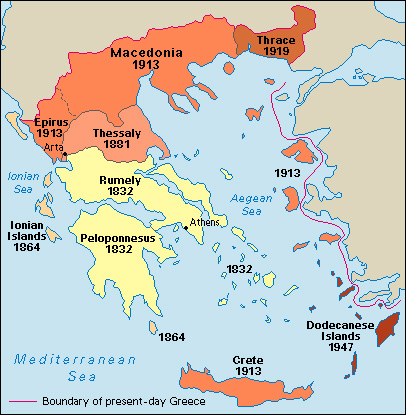
George I
gave Greece a much more democratic government than that of Otto. In 1864, a new constitution limited royal power and gave much power to an elected Parliament. Also in 1864, the United Kingdom turned over the Ionian Islands to Greece. In exchange, George pledged to discourage Greek revolts in Ottoman territory.
During the 1880’s and 1890’s, Greece made great progress. Roads and railroads were built. The merchant fleet was expanded. In addition, the educational system and other social services were improved.
In 1881, Greece acquired the region of Thessaly and the district of Arta in southern Epirus from the Ottoman Empire. The transfer had been suggested by the great European powers at the Congress of Berlin in 1878. In 1897, during a revolt in Ottoman-held Crete, war broke out between Greece and the Ottoman Empire. The European powers arranged peace after severe Greek defeats. They set up self-government for Crete in 1898 under a Greek high commissioner.
A group of young Greek army officers called the Military League organized a peaceful revolt in 1909. The league was protesting against political confusion and economic difficulties that had developed in Greece. The league called on Eleutherios Venizelos, a Cretan leader, to be its political adviser. The parliament agreed to the league’s demands for changes in the Constitution. Venizelos became prime minister in 1910. He carried out sweeping reforms in the Greek economy, armed forces, and civil service. Venizelos served as prime minister during much of the period until 1933.
Venizelos helped organize the Balkan alliance of Greece with Bulgaria, Montenegro, and Serbia. This alliance led to the two Balkan Wars of 1912 and 1913. In the first war, the four Balkan countries defeated the Ottoman Empire and took most of its European territory. In the second war, Bulgaria, dissatisfied with its gains, attacked its allies. Bulgaria was defeated. As a result of the Balkan Wars, Greece gained the island of Crete, southern Epirus, part of Macedonia, and many Aegean Islands. 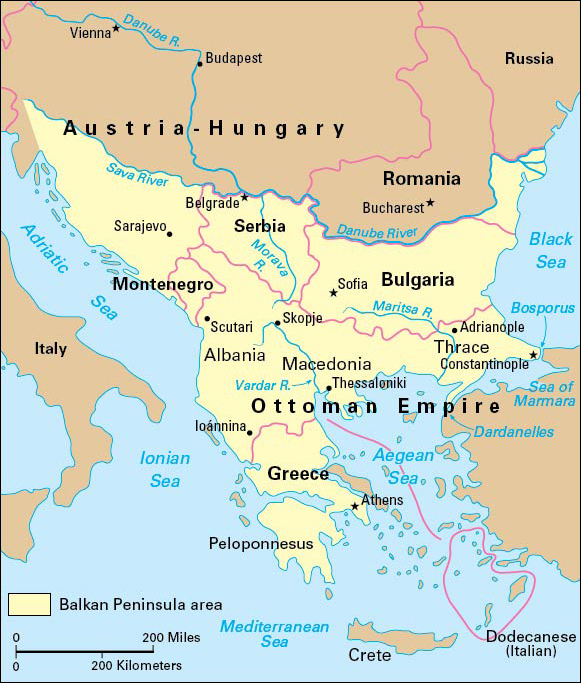
King George was shot by an assassin in 1913. His son Constantine I succeeded him.
World War I
began in 1914. Venizelos urged that Greece fight with the Allies against Germany and its partners. But King Constantine, whose wife was a sister of Kaiser Wilhelm II of Germany, kept Greece neutral. Venizelos started a revolutionary movement. It was supported by the Allies, who had established a military base at Thessaloniki. In 1917, Constantine was forced to give the throne to his son, Alexander I. Greece entered the war on the side of the Allies on July 2, 1917.
Thousands of Greek troops joined the British, French, and Serbians at their Thessaloniki base. In September 1918, the Greeks and other Allied forces moved north. They defeated the Bulgarians, who signed an armistice at Thessaloniki. The entire war ended on November 11.
The peace treaties that followed World War I gave Greece most of the territories it had long sought. From the Ottoman Empire, Greece got eastern Thrace and certain islands in the Aegean Sea. Greece also got temporary control of the Smyrna (now Izmir) region in Asia Minor. The Greeks gained western Thrace from Bulgaria.
Between world wars.
King Alexander died in 1920. Constantine I returned to the throne. In 1921, Constantine renewed the war against the Ottoman Empire by sending Greek forces into Asia Minor. The Ottomans dealt the Greeks a crushing defeat in 1922. A military revolt forced Constantine from the throne. Another of his sons, George II, replaced him. A revolution ended the Ottoman Empire in 1922. It became the Republic of Turkey the next year.
In 1923, under the Treaty of Lausanne, Greece returned the Turkish territories it had gained after World War I. The treaty also provided for ending the tensions produced by Turkish rule over Greeks. It required over 1,250,000 Greeks in Turkey to move to Greece and 400,000 Turks in Greece to move to Turkey. After the Greek migration, the only Greeks under foreign rule were in northern Epirus in Albania, British-held Cyprus, and the Italian-held Dodecanese Islands.
Another military revolt forced George II from the Greek throne late in 1923. The next year, Greece declared itself a republic. The republic lasted until 1935. This period was one of great political confusion and economic weakness. The people were divided between the republicans, who supported the republic, and the royalists, who wanted a king. Also, Greece’s economic resources could not keep up with its population. The population had been swollen by the refugees from Turkey and by a high birth rate. The worldwide economic depression of the 1930’s further weakened the Greek economy and the government.
The royalists returned to power in the elections of 1933. Two unsuccessful republican revolts took place, in 1933 and 1935. The government recalled George II to the throne later in 1935. The 1936 elections left the royalists and republicans almost evenly matched in Parliament. The balance of power rested with the Communists, who held 15 of the 300 seats. As a result, George permitted General Joannes Metaxas to establish a military dictatorship. On Aug. 4, 1936, the king dissolved Parliament without fixing a date for new elections. He also suspended the main provisions of the Constitution Metaxas remained dictator until his death in 1941.
World War II
began in 1939. Greece declared its neutrality. But on Oct. 28, 1940, Italy attacked Greece. Metaxas had refused to permit Italian troops to build military bases in Greece. The Greek forces were heavily outnumbered. But they pushed the Italians back deep into Albania. Germany came to the aid of Italy. On April 6, 1941, German forces poured into Greece and quickly defeated the Greeks. 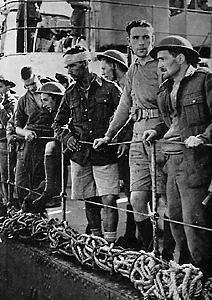
The Germans and their allies occupied Greece during the war. The Greeks suffered starvation, mass executions, and other tragedies. The country’s economy was almost destroyed. But the Greeks organized one of the best underground movements in all Europe. The largest and most effective of the several secret Greek resistance groups was the Communist-led National Liberation Front, known as EAM. Its military arm was the National Popular Liberation Army, or ELAS.
The Germans began to withdraw from Greece in September 1944. British forces landed in October. The British found EAM in control of most of Greece. Civil war broke out in Athens in December. The British fought ELAS until early in 1945, when ELAS stopped fighting and agreed to break up its forces The war in Europe ended in May 1945. Greece became one of the original members of the United Nations later that year.
Elections were held in March 1946. A royalist government was formed. In September, a referendum (direct vote) was held that favored having a king. George II returned to the throne. By the end of 1946, Communist-led rebels had begun to revolt against the government. The United Kingdom had supported the government by giving Greece economic support and military aid against the rebels. But it could no longer afford to do so. Under the Truman Doctrine, announced in March 1947, the United States took over the British support of Greece. A long, bitter civil war followed. The United States provided the government with massive military aid to defeat the rebels. By October 1949, the rebels were defeated.
King George died in 1947. He was succeeded by his brother, Paul I. Greece acquired the Dodecanese Islands under a 1947 peace treaty with Italy.
The 1950’s
brought economic recovery and political stability. Greece joined the North Atlantic Treaty Organization (NATO) in 1952. In 1953, Greece allowed the United States to set up military bases on its territory.
During the 1950’s, a serious dispute developed between Greece and Turkey over Cyprus, a British island colony off Turkey. Greeks made up about 80 percent of the island’s population. The rest were Turks. The Greeks of Cyprus demanded union with Greece and organized a revolutionary movement. The Greek government supported this demand. However, the United Kingdom—supported by the Turkish government—and Turkish Cypriots opposed it. After severe tensions, an agreement between Greece, Turkey, and the United Kingdom led to independence for Cyprus in 1960. See Cyprus (History).
In 1952, Greek women gained the right to vote and to hold political office. Field Marshal Alexander Papagos, head of the Greek Rally party, became prime minister that year. He held office until his death in 1955. Konstantinos Karamanlis, head of the National Radical Union party, succeeded him. Under Karamanlis, Greece’s economy expanded rapidly with continuing U.S. aid. The government improved finances, controlled rising prices, and encouraged the expansion of agriculture and industry. Karamanlis resigned in 1963.
The revolt of 1967.
George Papandreou of the Center Union party became prime minister of Greece in November 1963. Earlier, he had charged that the elections of 1961 had been rigged. He had also suggested that the army, with support from the monarchy, stood in the way of democracy. King Paul died in 1964. His son came to the throne as Constantine II. Constantine clashed with Papandreou over the king’s political powers and control of the armed forces. The king manipulated Papandreou into resigning in 1965. Political confusion developed. The government remained shaky. In an effort to achieve a stable government, Parliament was dissolved on April 14, 1967. New elections were called for May 28. But these elections never took place.
On April 21, 1967, Greek army units equipped with tanks and armored cars seized the royal palace, government offices and leaders, and radio stations. Three army officers then set up a military dictatorship. This junta consisted of Colonel George Papadopoulos, its leader; Brigadier General Stylianos Pattakos; and Colonel Nicholas Makarezos. The junta prohibited all political activity and made mass arrests. It replaced the leader of the Greek Orthodox Church. It also imposed harsh controls on newspapers and dissolved hundreds of private organizations of which it disapproved.
Constantine remained head of state, though powerless. On Dec. 13, 1967, he tried to overthrow the junta. He failed. He and his family then fled to Italy. The junta named a regent to substitute for the king.
Papadopoulos named himself prime minister and minister of defense. He pardoned many political prisoners. But he kept about 2,000 others, mostly Communists, in prison. He loosened some controls on the press. To win popularity, he canceled bank debts of the peasants. In 1968, the junta had a new constitution drawn up. The Constitution provided for a stable government, but at the expense of democracy. It increased the prime minister’s power and suspended freedom of the press, parliamentary elections, and various individual rights.
The restoration of democracy.
In May 1973, a group of naval officers led an unsuccessful mutiny aboard a Greek destroyer. The government said the mutiny was part of an attempted coup supported by King Constantine. In June, Papadopoulos announced the end of the monarchy and proclaimed Greece a republic. He became president in August and began to prepare the country for parliamentary elections. On Nov. 25, 1973, a group of military officers who opposed Papadopoulos’s liberalizing policies overthrew the government. The group’s leader, Lieutenant General Phaidon Gizikis, became president.
The conflict between Greece and Turkey over Cyprus was renewed in 1974. Greek officers led Cypriot troops in overthrowing the government of Cyprus. Turkey claimed that Greece had violated the independence of Cyprus. Turkish troops invaded the island. After several days of fighting, a cease-fire was signed to prevent full-scale war between Greece and Turkey.
The crisis in Cyprus and economic recession paralyzed Greece’s military government. Shortly after the cease-fire was signed, the government collapsed. Military leaders invited Konstantinos Karamanlis, who had opposed Greece’s military government, to become prime minister again. On July 24, 1974, Karamanlis was sworn in as prime minister of a civilian government.
In November 1974, Greece held its first free elections in more than 10 years. Karamanlis’s New Democracy Party won the elections by a wide margin. In December, Greek voters chose to make the country a republic rather than a monarchy. Parliament adopted a new constitution in 1975. Civilian control over the military was gradually established. Papadopoulos, Pattakos, and Makarezos were found guilty of treason for their roles in the 1967 revolt. They received sentences of life in prison. The New Democracy Party retained its majority in 1977.
In 1980, Karamanlis resigned as prime minister. George Rallis succeeded him. In 1981, Greece joined the European Community. In 1993, the European Community was incorporated into the European Union (EU), which works for both economic and political cooperation among its member nations.
In October 1981, the Panhellenic Socialist Movement (PASOK) party won control of Parliament. It became the first socialist government in the history of Greece. As head of the party, Andreas Papandreou—son of former Prime Minister George Papandreou—became prime minister. The government increased social benefits and personal incomes.
In June 1985, PASOK won elections again. Papandreou began a second term as prime minister. PASOK was defeated in June 1989. A coalition government was formed. Because of political instability, it collapsed in early 1990. Elections were held in April. The New Democracy Party won control of Parliament. Constantine Mitsotakis became prime minister. PASOK won elections in October 1993. Papandreou again became prime minister.
In January 1996, Papandreou resigned because of ill health. Costas Simitis replaced him. Papandreou died in June. In October, PASOK won elections. Simitis remained prime minister. In 2004, the New Democracy Party won control of Parliament. Kostas Karamanlis, the nephew of Konstantinos Karamanlis, became prime minister. PASOK regained power in October 2009. George Papandreou, son of Andreas, became prime minister.
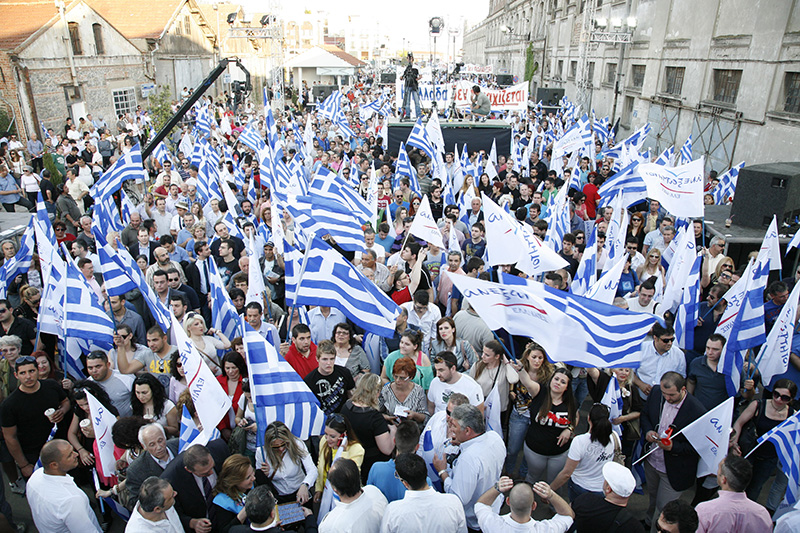
Recent developments.
Athens hosted the 2004 Summer Olympic Games. It was the first time since 1896 that the Olympics were held in Greece, where they had originated in ancient times.
Greece began using the euro, the common currency of most EU nations, in 2001. By 2009, Greece’s federal budget had developed a severe deficit. By 2010, Greece’s financial problems threatened to weaken the euro and lead to higher interest rates for other European nations. In 2010, 2012, and 2015, Greece received a total of more than 300 billion euros ($340 billion) in emergency loans from the International Monetary Fund (IMF) and the countries that use the euro. Greece’s economy began to grow again in the late 2010’s. 
In December 2008, youths rioted in Athens after a teenager was shot and killed by police. Rioting and looting soon spread to other Greek cities, and protests against police brutality continued for weeks. Many protests included calls for authorities to address unemployment and alleged government corruption.
Prime Minister Papandreou resigned in November 2011. Lucas Papademos, an economist and former vice president of the European Central Bank, was named prime minister. The New Democracy Party won the most seats—but not a majority—in June 2012 elections. New Democracy leader Antonis Samaras became Greece’s new prime minister and formed a coalition government. In December 2013, Constantine II—Greece’s last and former king—returned to live in Greece. Constantine had been forced into exile after the revolt of 1967.
Greece became the center of a migration crisis in Europe in 2015, as millions of people fled a civil war and terrorism in Syria. Many migrants attempted to reach Europe by crossing the Mediterranean Sea, and migration centers on many Greek islands became overwhelmed.
In January 2015, the far-left SYRIZA party won parliamentary elections. SYRIZA leader Alexis Tsipras became Greece’s new prime minister and formed a coalition government. Economic and political turmoil, however, led Tsipras to resign in August. Supreme Court judge Vassiliki Thanou then briefly became Greece’s first woman prime minister. Voters returned Tsipras to power in September elections. In July 2019, the New Democracy Party won a majority in Parliament. Its leader, Kyriakos Mitsotakis—a son of former prime minister Constantine Mitsotakis—became prime minister. In 2020, Katerina Sakellaropoulou—a judge, constitutional law expert, and human rights advocate—became the country’s first woman president. 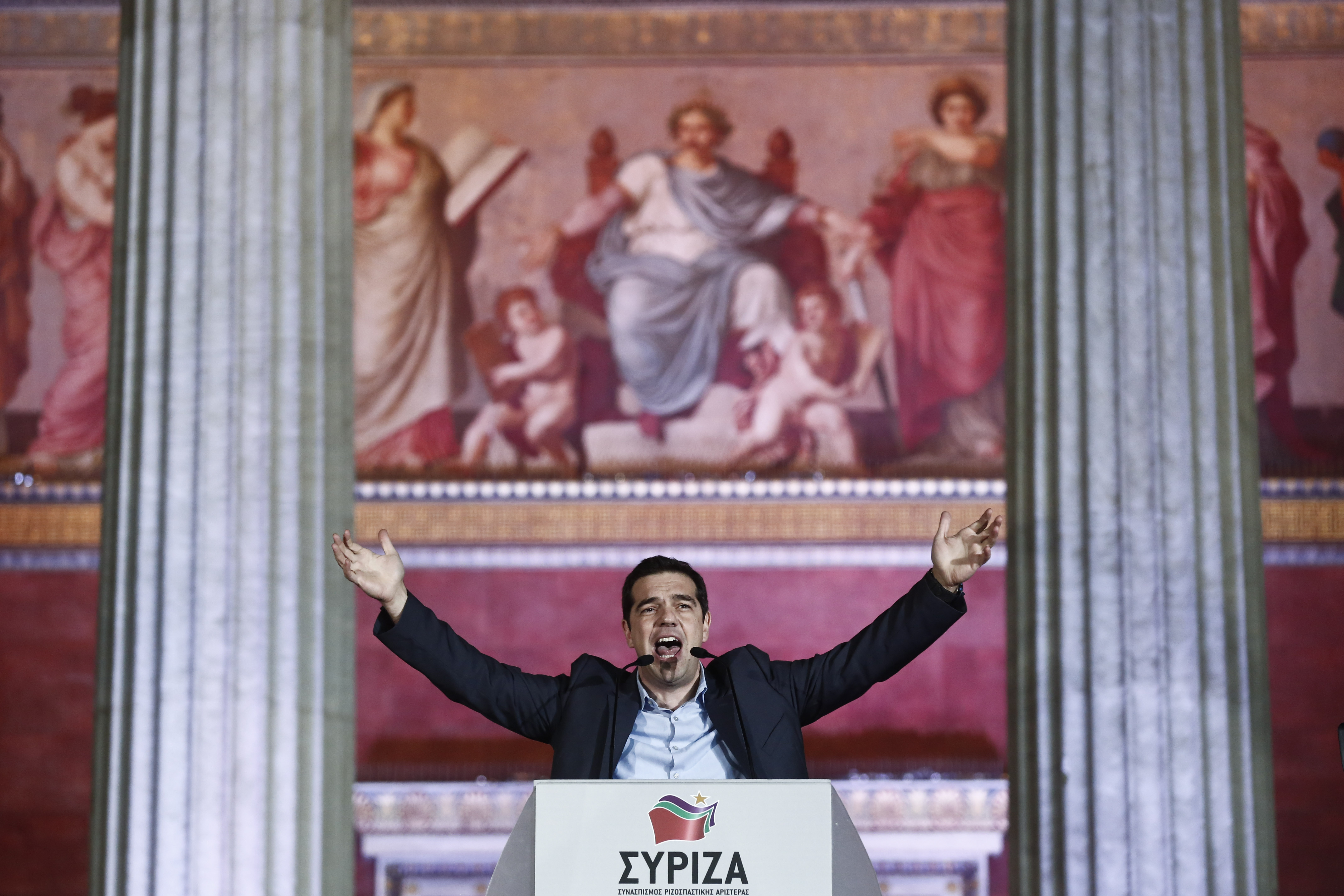
Some of the largest wildfires in Greece’s history burned in the 2020’s. In the summer of 2021, fires raged outside Athens, in the Peloponnesus, and on the island of Euboea. The fires accompanied a dangerous heat wave and severe drought conditions. Hundreds of wildfires that started in August 2023 also caused great devastation. A fire in the Evros region in northeastern Greece killed 20 people and ranked among the largest in European history. A blaze that began in the foothills of Mount Parnitha, north of Athens, forced the evacuation of several villages and covered the capital’s skies with smoke.
Beginning in 2020, the COVID-19 pandemic led to major economic and social disruptions in Greece and around the world. In 2021, the distribution of COVID-19 vaccines became a major focus of government efforts to combat the disease. By early 2023, about 35,000 people in Greece had died from COVID-19.
In parliamentary elections in May 2023, Mitsotakis’s New Democracy Party won the most seats, but not a majority. Mitsotakis then sought another round of elections so his party could try to win enough seats to govern without forming a coalition. In elections held in June, the New Democracy Party won a majority in Parliament. Mitsotakis returned as prime minister.
